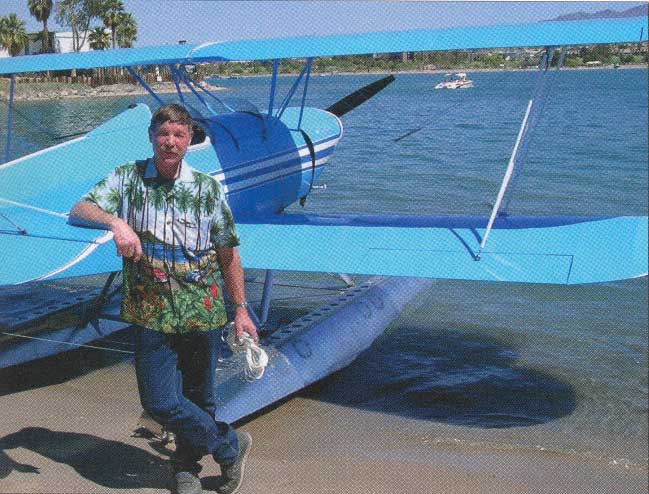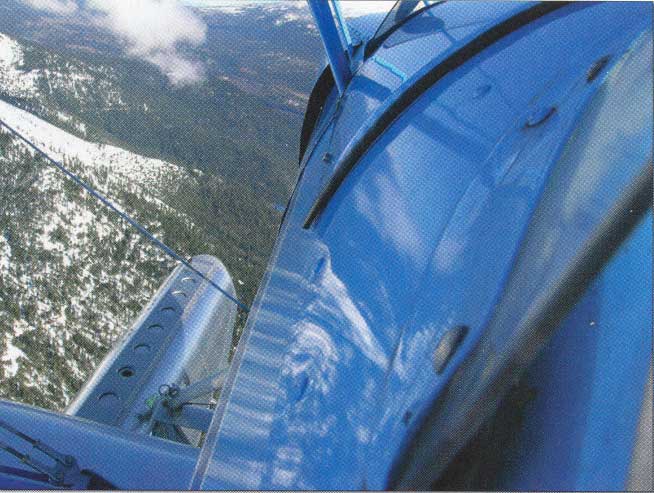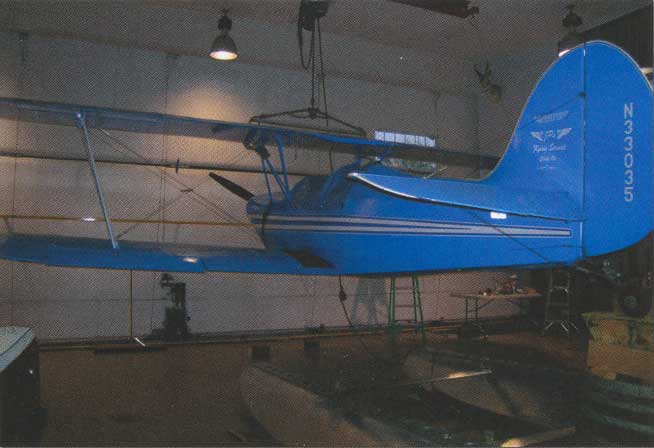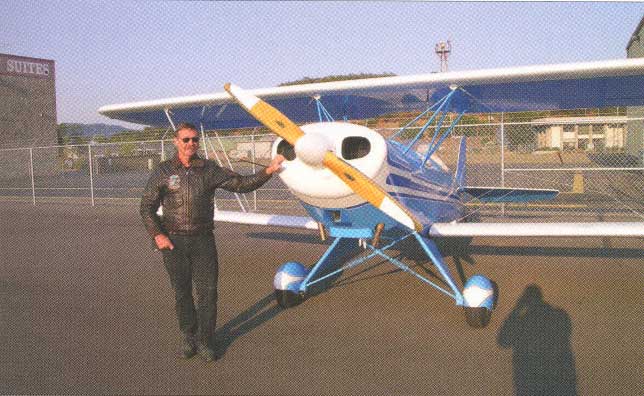By Ishmael Fuentes

John Proctor has explored more corners of aviation than most of us. He’s flown a hot air balloon across a big chunk of the United States, a Cessna 185 across the Atlantic Ocean and Russia, and a restored Grumman Albatross around the Pacific. Now he has taken up an aspect of flying that few modern pilots have tried, or even considered: a biplane on floats. Not just that, but a home built biplane on floats-and for good measure, a home built biplane on amphibious floats. John’s current mount is a small Hatz biplane that he’s flown all over the West and Southwest. He almost never got the chance to fly it at all.
In November 2001, a painfully stiff neck sent John to the doctor. There, to his unpleasant surprise, he was diagnosed with throat cancer. This was a complete shock, because he had never used tobacco products or drugs in his life. It proved to be an especially aggressive tumor that eventually involved the mastoid muscle and the jugular vein, which made surgery risky. When standard treatments were not effective and the knot in his neck reached the size of a lemon, surgery became the only option. Somehow he survived that, and the violent radiation treatment that followed.
“I’ve never been a timid person,” John says, “and I told the doctors to pour it on. One way or another, I’m dead, but I’m not going without a fight.” The doctors did as he asked and the next few months were truly awful. “If I’ d known up front what I would have to go through, I don’t know that I would have had the courage to do it,” he said. “I fought it every day, but what really kept me alive was a support group of neighbors and friends.”
As his recovery progressed, he regained his medical (though the FAA requires extensive tests every year) and allowed himself to think about flying again. At precisely the right time, the perfect therapeutic tool appeared in the form of the baby-blue Hatz biplane that John named Cloud Dancer.
For those not familiar with the Hatz, imagine a Great Lakes with straight wings. The design has been around since the late 1960s when the Hatz CB-1 was introduced by designer John Hatz of Gleeson, Wisconsin. It is a conventional small biplane with a steel-tube fuselage and wood-frame wing, both fabric covered. The two wings have a span of 25.5 feet and an area of 178 square feet.

Cloud Dancer was originally built in 1990, in Colorado, by Irving Siewert and soon made its way to Ashland, Oregon, where Ron Bartley put 280 hours on it over 14 years. In 2004, Ron decided that 20 hours a year just wasn’t enough to justify continued ownership, so he posted a few notices on local bulletin boards. John saw the photographs and recognized the airplane. He’d seen it before his illness and remembered it as an exceptionally well-built and cared for example. He bought the airplane and brought it back to the grass runway at his air park home on the North Umpqua River, near Roseburg, Oregon.
In the Air Again
Almost immediately, he decided to celebrate his new life with a loose and unstructured trip. The Hatz would not be every pilot’s choice for a cross-country airplane. With only 135 horsepower pulling a high-drag air frame, it’s not fast, and with 17 gallons on board it doesn’t go far without refueling. Cruise speed is about 105 mph, and legs are 2 hours at the most. But the autumn promised good weather and he had no particular agenda, so John loaded some personal effects, filled the tank and headed across the Cascade Mountains. The trip would eventually take him through 14 states, as far away as Nebraska and Texas. After 25 days and 97 hours of flying, he ended up in his childhood home of San Diego.

There must be something about San Diego, because once again, his thoughts turned to water flying. As a boy, John had watched the Navy’s Grumman Albatrosses flying off the bay, filling the basin with the sound of hard-working radial engines. Much later, he sold his successful construction company and bought one of the very same Albatrosses he had seen.

For three years he worked on restoring the airplane, fitting it with all the comforts of home including a washer/dryer. Then, he and his wife (now ex-wife, also a pilot) left on a trip around the Pacific Rim. For 18 months, 42,500 miles and 52 water landings in nine oceans, from the Arctic to the Antarctic, John, with an ATP and an A&P, was the senior pilot, mechanic and flight planner. He carried the title of “Master of Ocean Flying Boats,” the same one given to Pan American Clipper pilots. “It was an adventure, everything you’d expect from taking a big flying boat that’s usually crewed by eight people around the world with two,” he said.
Fitting the Floats

He flew the Hatz back to Oregon in the spring, determined to see if it could be mounted on floats. There wasn’t much information on the subject; nobody had even thought about putting floats on a Hatz. Mike Mann, a local airplane builder from Cottage Grove, a few miles north of Roseburg, suggested he look into some Czech floats that were just becoming available. “They are nice floats,” John says.”They’re very light, and the craftsmanship is very good. I ended up dealing directly with the factory in the Czech Republic. They were great people…very responsive.” John, Mike and a crew worked for several weeks getting the Hatz fitted to the floats, or vice versa. Mike had done some work on a Waco biplane with floats for an Indiana Jones movie, so at least one of them had some experience.

Fitting floats to a small biplane is an interesting challenge. For instance, keeping the fuselage close to the floats is good for stability, but it makes it easier to catch a wingtip and the prop can pick up lot of water. And where do you place the floats fore and aft? Further forward gives better stability and lessens the chance of “digging in” and cartwheeling, but go too far and the floats start driving the airplane. If the floats are too far back the airplane can’t rotate for takeoff.
The distance between the floats also affects stability and maneuverability on the water. Sometimes float planes must make high-speed step-taxi turns to get out of a small pond. If the distance between the floats is too great, this maneuver puts tremendous vertical loads on the struts to the fuselage. If it’s too narrow, the airplane becomes difficult to control on the water. And, of course, when the airplane’s in the air, the weight and placement of the floats affects the aerodynamic c.g. of the airplane. Figuring it all out involved many hours with wood lx2 mock-up legs and braces, moved here and there while the aircraft was hanging from a crane.
Many Mods
John’s many years of exposure to airplanes that both float and fly have taught him that there are many small things that must be provided to make water handling convenient and safe. He built steps on the lower engine mount so he could have a place to stand while filling the fuel tank in the top wing there’s no place to put a ladder on water! He added handling lines to the upper wingtip and built an aluminum stinger for the tail that extends just past the rudder. (Ever drifted backward into a sea wall?) He installed cleats for mooring and sealed up holes in the wing root and fuselage where the landing gear used to be (it can get exciting when extra water “ballast” migrates to a wingtip or tail).

The hand hydraulic pump, pressure gauge and selector for the wheels are on the left side of the cockpit so the pilot can fly with his right hand and pump with left. He built a storage box for the front cockpit and removed the front stick and seat cushions. The empty weight, on floats, is 1020 pounds, so it will be a single-seat airplane anyway.
Finally, it was time to see how the airplane handled. Taxi testing commenced in early February at Cottage Grove. The first flight was on February 12, 2006.
“The ground taxi tests were interesting,” John says. “I tried a fast taxi to liftoff speed with an engine cut at rotation. Surprise, no rotation! Finally, I figured out you must rotate aggressively. By that, I mean pull the stick back right to the stop, and when the nose does come up, push forward to stabilize. When I was comfortable with that, I made the full takeoff. The first flight was just an extended pattern. When I pulled the power back, boy, did it decelerate. There’s lots of drag. Landing on amphibs is interesting because you have to visualize all that distance underneath the fuselage. On land, I make a normal small biplane approach, a steady turn right to the flare. I leave lots of room to slow down because, like most amphib floats, the brakes are marginal.”
Further test flying showed that stall speed went up 4 miles an hour to about 51 mph, but handling was otherwise normal. So, off to the lake! On his first water landing, John touched the water at 60 and step taxied for a while to check pitch and yaw control. It was good, so he cut the power, pulled the stick all the way back and let Cloud Dancer settle smoothly. Takeoffs turned out to be a non-event, although everyone was surprised when the Hatz beat Mike Mann’s Super Cub off the water. “You have to be very gentle, especially if the surface of the water is rough,” John said. “It’s a bit like a helicopter; a little control input goes a long way.”
John has been flying the Hatz on floats ever since. He’s had it to several splash-ins on the West Coast, flown it back to San Diego, and landed on the Colorado River. Back home in Oregon, he pilots it whenever he’s not doing volunteer flying for local agencies in his Cessna 185 or Super Cub. When he’s not flying, he’s working on his next project, the SeaDuster, a highly modified Starduster biplane with a 400-hp supercharged Vedenyev M14 radial and, of course, amphibious floats.

This article originally appeared in the March 2007 issue of KITPLANES magazine.
